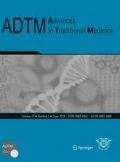Abstract
To compare the efficacy of two Unani regimen in diabetic vulovaginal candidiasis (VVC). A prospective, randomized, single-blind, comparative trial was conducted at Nizamia Tibbia College. Group A (n = 23) medicine included 100 ml of Joshanda [Ushba Desi (5 g) and Tukhme Hayat (5 g)] with 3 g Sufuf [Mur Makki (1 g), Afsanteen (2 g), and Nagandbabari (3 g)] orally twice daily half an hour before meal. Locally, douche (Aab Barg Bakayan (5 g) and Sufuf Katha (1 g) followed by humul [Roghan Neem (10 ml), Luab Gheegawar (2 g) and Sufuf Zard Chobb (1 g)] was given daily once. Group B (n = 23) received 100 ml of aforementioned Joshanda with 3 g sufuf [Kutki Siyaha (2 g), Kali Zeeri (2 g) and Tukhme Kasni (2 g)] orally twice daily half an hour before meal. Locally, douche (Gulanar (5 g) and Barg babool 5 (g)] was given daily once. Both groups received the treatment for 10 days for three consecutive months. The primary outcomes included change in vaginal discharge and wet mount test. The secondary outcomes included other clinical features of VVC and blood glucose level. The results were analyzed. Group A and B showed absence of vaginal discharge and fungal spores/hyphae in 91.30% and 86.95% respectively, statistically not significant (P = 0.3), whereas pre- and post-test comparison was statistically significant in both groups (P < 0.001). Inter-group comparison was statistically non significant (P > 0.05) for remission of other clinical features and blood glucose level, whereas pre- and post-test comparison showed statistically significant difference in both groups (P < 0.001). Both groups were equally effective for the treatment of diabetic VVC.

Similar content being viewed by others
References
Amir F, Chin KY (2011) The chemical constituents and pharmacology of Centratherum Anthelminticum. Int J Pharm Tech Res 3(3):1772–1779
Bapat V, Alfred L, Rani RH, Ksheerasagar T, Hegde G, Lund SK (2009) Preliminary clinical study of a Polyherbal formulation (Wh1) in the treatment of vaginitis. Indian J Pharm Pract 1(2):68–74
Bora KS, Sharma A (2011) The genus Artemisia: a comprehensive review. Pharm Biol 49(1):101–109. doi:10.3109/13880209.2010.497815
Chapple A, Hassell K, Nicolson M, Cantrill J (2000) You don't really feel you can function normally: women's perceptions and personal management of vaginal thrush. J Reprod Infant Psychol 18:309–319
Faraji R, Rahimi MA, Rezvanmadani F, Hashemi M (2012) Prevalence of vaginal candidiasis infection in diabetic women. Afr J Microbiol Res 6(11):2773–2778
Gayathri M, Kannabiran K (2008) Hypoglycemic activity of Hemidesmus indicus R. Br on streptozotocin-induced diabetic rats. Int J Diabetes Dev Ctries 28(1):6–10. doi:10.4103/0973-3930.41979
Gayathri M, Kannabiran K (2009) Antimicrobial activity of Hemidesmus indicus, Ficus bengalensis and Pterocarpus marsupium Roxb. Indian J Pharm Sci 71(5):578–581. doi:10.4103/0250-474X.58182
Ghani N (2001) Khazianul Advia. Munshi Naval Kishore Press, Lucknow, pp 245, 308, 339, 379, 945, 997, 1009, 1025, 1129, 1138, 1318, 1357
Khan M (2007) Clinical study of sailanur rahem and its management with unani formulation. Dissertation. Rajiv Gandhi University of Health Sciences
Khare CP (2007) Indian Medicinal Plants An Illustrated Dictionary. Springer, USA, pp 4, 5, 36, 63, 80, 137, 187, 306, 346, 403, 485, 527, 719
Masood M, Arshad M, Qureshi R, Sabir S, Amjad MS, Qureshi H, Tahir Z (2015) Picrorhiza kurroa: an ethnopharmacologically important plant species of Himalayan region. Pure Appl Biol 4(3):407–417
Maurya R (2010) Chemistry and pharmacology of Withania coagulans: an Ayurvedic remedy. J Pharm Pharmacol 62(2):153–160. doi:10.1211/jpp.62.02.0001
Middha SK, Usha T, Pande V (2013) A review on antihyperglycemic and antihepatoprotective activity of eco-friendly Punica granatum Peel Waste. Evidence-Based Complementary and Alternative Medicine Article ID 656172, 10 pages doi:10.1155/2013/656172/. Accessed 25 Sept 2016
Paavonen J, Mangioni C, Martin MA, Wajszczuk P (2000) Vaginal clindamycin and oral metronidazole for bacterial vaginosis: a randomized trial. Obstet Gynecol 96:256–260
Panchal GA, Panchal SJ, Patel JA (2009) Hemidesmus indicus: a review. Pharmacol Online 2:758–771
Pillai NR, Santha Kumari G (1981) Hypoglycemic activity of Melia azadirachta indica. Indian J Med Res 74:931–933
Salama A, Ibrahim W, El-Nimr T, Abd El-Rahman MA, Tousson E (2014) Effect of myrrh extract (Mirazid®) on experimentally diabetic rats. Pharmacologia 5:135–142. doi:10.5567/pharmacologia.2014.135.142
Shrivastav VK, Shukla D, Shrivastav A, Jana AM (2015) Prevalence of vaginal candidiasis in diabetic women of Madhya Pradesh, India. Int J Curr Microbiol App Sci 4(5):834–846
Sina I (2010) Al Qanoon Fit Tib (Urdu trans. by Kantoori GH). Idarae Kitabul Shifa, New Delhi, pp 454, 1065, 1095
Stohs SJ, Bagchi D (2015) Antioxidant, anti-inflammatory and chemoprotective properties of Acacia catechu heartwood extracts. Phytother Res 29(6):818–824. doi:10.1002/ptr.5335
Street RA, Sidana J, Prinsloo G (2013) Cichorium intybus: Traditional Uses, phytochemistry, pharmacology, and toxicology. Evidence-Based Complementary and Alternative Medicine Article ID 579319, 13 pages doi:10.1155/2013/579319. Accessed 25 Sept 2016
van Schalkwyk J, Yudin MH (2015) Vulvovaginitis: screening for and Management of Trichomoniasis, vulvovaginal candidiasis, and bacterial vaginosis. J Obstet Gynaecol Can 37(3):266–274
Zaki M, Begum W, Mariyam R (2016) Efficacy of amla (Emblica officinalis) and shibe yamani (potash alum) in the management of Candida vaginitis: a randomized standard controlled trial. Int J Reprod Contracept Obstet Gynecol 5(5):1601–1606. doi:10.18203/2320-1770.ijrcog20161333
Zhang Y, Liu W, Liu D, Zhao T, Tian H (2016) Efficacy of Aloe Vera supplementation on prediabetes and early non-treated diabetic patients: a systematic review and meta-analysis of randomized controlled trials. Nutrients 8(7). doi:10.3390/nu8070388
Acknowledgements
The authors are thankful to the patients and staffs of Nizamia Tibbia College for their support in carrying this work.
Author information
Authors and Affiliations
Corresponding author
Ethics declarations
Ethical statement
Institutional Ethical clearance and informed consent was obtained.
Conflict of Interest
The authors declare that there are no conflicts of interests.
Rights and permissions
About this article
Cite this article
Fatima, S.S., Sultana, S. & Sultana, A. A comparative study of two unani regimens in diabetic vulovaginal candidiasis. Orient Pharm Exp Med 17, 19–27 (2017). https://doi.org/10.1007/s13596-017-0258-x
Received:
Accepted:
Published:
Issue Date:
DOI: https://doi.org/10.1007/s13596-017-0258-x



